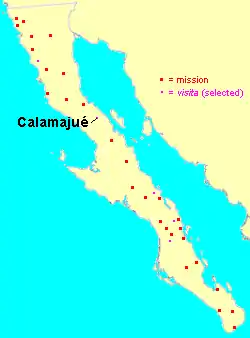Visita de Calamajué
The Cochimí settlement of Calamajué in Baja California, Mexico was briefly, in 1766–1767, a Jesuit mission.

About 90 kilometers north of San Borja, Calamajué was found by the Jesuit missionary-explorer Ferdinand Konščak in 1751 and revisited in 1766 by Wenceslaus Linck. It was intended to become the site of Mission Santa María. In October 1766, the Jesuits founded their 17th mission here. In just a few months, the crops failed due to the highly mineralized water available. However, a more suitable site for the mission was found about 50 kilometers farther north, at Cabujakaamung, following seven months of mission activity at Calamajué.
Calamajué also served as a travel station on the Camino Real Misionero between San Borja and Santa María. Adobe ruins and rock corrals now mark the location.
References
- Vernon, Edward W. 2002. Las Misiones Antiguas: The Spanish Missions of Baja California, 1683–1855. Viejo Press, Santa Barbara, California.
- Kier, David. 2016. Baja California Land of Missions
M&E BOOKS, El Cajon, California.
See also
- Missions in Baja California